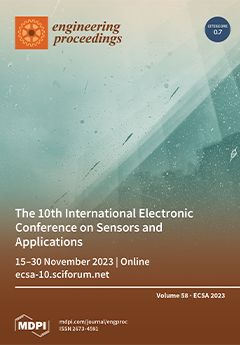Individuals who spend most of their time indoors are especially sensitive to indoor air quality (IAQ), which significantly impacts their general well-being and health. Traditional IAQ measurement techniques, however, are frequently pricy, complicated, and labor-intensive. In this study, we used a low-cost, simple-to-use,
[...] Read more.
Individuals who spend most of their time indoors are especially sensitive to indoor air quality (IAQ), which significantly impacts their general well-being and health. Traditional IAQ measurement techniques, however, are frequently pricy, complicated, and labor-intensive. In this study, we used a low-cost, simple-to-use, and handy sensor system to track the levels of carbon dioxide (CO
2), nitrogen dioxide (NO
2), ozone (O
3), particulate matter (PM
1.0, PM
2.5, and PM
10), temperature, and relative humidity (RH) in a laboratory at the Bamidele Olomilua University of Education, Science, and Technology in Ikere-Ekiti for a month. We contrasted the outcomes with other benchmarks and WHO recommendations. However, the NO
2 levels (144.00–303.00 ppb) exceeded the suggested levels (National Institute for Occupational Safety and Health (NIOSH)—70 ppb; National Ambient Air Quality Standards (NAAQS)—100 ppb; National Environmental Standards and Regulations Enforcement Agency (NESREA)—120 ppb; and World Health Organization (WHO)—25 ppb), suggesting a possible cause of indoor contaminants. We also noticed that the temperature and humidity varied considerably throughout the day, which impacted the inhabitants’ thermal comfort and ventilation. The principal component analysis (PCA) findings indicate that particulate matter, the weather, photochemical reactions, and combustion processes are the key contributors to fluctuation in the air quality measurements. Based on their quantities and relationships, these elements can have a variety of effects on both the natural environment as well as well-being. Our monitoring device can give immediate information and warnings, assisting in locating and reducing indoor airborne pollutant sources and enhancing indoor air quality (IAQ). This work shows that adopting a low-cost sensor system for IAQ measurement in underdeveloped nations, where such data are sparse and frequently erroneous, is both feasible and beneficial.
Full article




